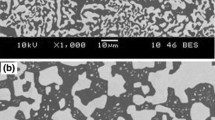Abstract
Creep behavior of the lead-free Sn–Bi alloys with bismuth contents in the range of 1–5 wt.% was studied by long time Vickers indentation testing at room temperature. The materials were examined in the homogenized cast and wrought conditions. The stress exponents, determined through different indentation methods, were in good agreement. The exponents of 13.4–15.3 and 9.2–10.0, found respectively for the cast and wrought conditions, are close to those determined by room-temperature conventional creep testing of the same material reported in the literature. Due to the solid solution hardening effects of Bi in Sn, creep rate decreased and creep resistance increased with increasing Bi content of the materials. Cast alloys, with a rather coarser grain structure and some Bi particles at the grain boundaries, showed typically higher resistance to indentation creep compared to the wrought materials. These two factors have apparently resulted in a less tendency of the material for grain boundary accommodated deformation, which is considered as a process to decrease the creep resistance of soft materials.









Similar content being viewed by others
References
A.R. Geranmayeh, R. Mahmudi, J. Elec. Mater. 34, 1002 (2005)
M. Abtew, G. Selvaduray, Mater. Sci. Eng. R 27, 95 (2000)
M.D. Mathew, H. Yang, S. Movva, K.L. Murty, Metall. Mater. Trans. 36A, 99 (2005)
F. Ochoa, X. Deng, N. Chawala, J. Elec. Mater. 33, 1596 (2004)
N. Wade, K. Wu, J. Kunii, S. Yamada, K. Miyahara, J. Elec. Mater. 30, 1228 (2001)
F. Wang, X. Ma, Y. Qian, Scripta Mater. 53, 699 (2005)
R.A. Islam, B.Y. Wu, M.O. Alam, Y.C. Chan, W. Jillek, J. Alloys Compd. 392, 149 (2005)
D. Mitlin, C.H. Raeder, R.W. Messler, Metall. Mater. Trans. 30A, 115 (1999)
T. Reinikainen, J. Kivilahti, Metall. Mater. Trans. 30A, 123 (1999)
L.L. Duan, D.Q. Yu, S.Q. Han, H.T. Ma, L. Wang, J. Alloys Compd. 381, 202 (2004)
C.W. Hwang, K. Suganuma, Mater. Sci. Eng. A373, 187 (2004)
H.L. Lai, J.G. Duh, J. Elec. Mater. 32, 215 (2003)
H.W. Miao, J.G. Duh, Mater. Chem. Phys. 71, 255 (2001)
F. Yang, J.C.M. Li, Mater. Sci. Eng. A201, 40 (1995)
F.J. Wang, X. Ma, Y.Y. Qian, J. Mater. Sci. 40, 1923 (2005)
M. Fujiwara, M. Otsuka, Mater. Sci. Eng. A319–321, 929 (2001)
T. El-Ashram, R.M. Shalaby, J. Elec. Mater. 34, 212 (2005)
R. Mahmudi, A. Rezaee-Bazzaz, Mater. Letts. 59, 1705 (2005)
T. Ogawa, R. Kaga, T. Ohsawa, J. Elec. Mater. 34, 311 (2005)
H. Rhee, J.P. Lucas, K.N. Subramanian, J. Mater. Sci.: Mater. Electron. 13, 477 (2002)
R. Mahmudi, R. Roumina, B. Raeisinia, Mater. Sci. Eng. A382, 15 (2004)
R. Roumina, B. Raeisinia, R. Mahmudi, Scripta Mater. 51, 497 (2004)
A.R. Geranmayeh, R. Mahmudi, J. Mater. Sci. 40, 3361 (2005)
A. Juhasz, P. Tasnadi, I. Kovacs, J. Mater. Sci. Lett. 5, 35 (1986)
P.M. Sargent, M.F. Ashby, Mater. Sci. Tech. 8, 594 (1992)
G. Cseh, J. Bar, H.J. Gudladt, J. Lendvai, A. Juhasz, Mater. Sci. Eng. A272, 145 (1999)
B. Walser, O.D. Sherby, Scripta Metall. 16, 213 (1982)
G. Saad, F. Abd-Elsalam, M.T. Mostafa, Surf. Technol. 23, 73 (1984)
R. Mahmudi, A.R. Geranmayeh, A. Rezaee-Bazzaz, J. Alloys Compd. 427, 124 (2007)
Acknowledgments
The authors thank the Iran National Science Foundation (INSF) for providing financial support of this work under Grant No. 84094/26.
Author information
Authors and Affiliations
Corresponding author
Rights and permissions
About this article
Cite this article
Mahmudi, R., Geranmayeh, A.R., Mahmoodi, S.R. et al. Room-temperature indentation creep of lead-free Sn–Bi solder alloys. J Mater Sci: Mater Electron 18, 1071–1078 (2007). https://doi.org/10.1007/s10854-007-9124-9
Received:
Accepted:
Published:
Issue Date:
DOI: https://doi.org/10.1007/s10854-007-9124-9



